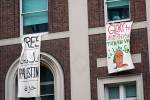Thanksgiving-type congestion may become norm for McCarran
That airport congestion we’re expecting to see during the Thanksgiving holiday next week?
Get used to it, especially at McCarran International Airport, the U.S. Travel Association says.
The Washington, D.C.-based organization that is an advocate for the $2.1 trillion travel industry said Tuesday that every day will feel like the Wednesday before Thanksgiving at McCarran beginning in 2015, 10 years earlier than forecast. Only Chicago’s Midway International Airport has a worse outlook among the nation’s 30 top airports.
But officials at McCarran say they don’t think the projections are as dire as the association presented them, noting that McCarran has some unique characteristics that make its operation different than other airports.
Executives with the association say it’s more critical than ever that the United States develop a national transportation policy to address airport infrastructure issues with more international destinations with superior airports doing more to attract tourists and economic development.
The association said the problem stems from chronic underinvestment in infrastructure coupled with a steady increase in travel demand.
The association’s position is based on a report by Cambridge, Mass.-based Cambridge Systematics that asked, “If the U.S. fails to modernize its
airport infrastructure and air traffic control system, when can travelers expect Thanksgiving-type congestion on a regular basis?”
The report is a follow-up to the Travel Association’s “Thanksgiving in the Skies” report that was issued a year ago.
“The already bad news about our overwhelmed travel system has gotten worse since last year,” association President and CEO Roger Dow said in a teleconference. “”If you hate traveling around Thanksgiving because of the crowds and chaos, unfortunately we’re well within sight of a time when it’s going to be like that every time you head to the airport.”
CONGESTION LEVELS RISING
The Cambridge research said six of the 30 largest U.S. airports were already experiencing congestion levels equal to the Wednesday before Thanksgiving one day a week on average. This year, the number of airports at that level of congestion more than doubled to 13.
Twenty airports will reach Thanksgiving congestion levels two days a week within five years and 26 of the 30 airports will hit daily congestion levels sooner than expected.
Dow said the American aviation system was once the envy of the world with modern terminals and superior facilities. But now, more modern airports have been built overseas and the United States has fallen behind competitively.
Infrastructure improvements range from new runways and terminals with upgraded baggage claim facilities to next-generation air traffic control systems that could expand the volume of managed air traffic in American airspace.
The Cambridge analysis was based on volume data collected by Orbitz on transactions representing 94 percent of passengers. For McCarran, the report showed that the airport hit Thanksgiving levels of capacity one day a week in 2012, a year ahead of projections, that it hit high levels twice a week in 2013, three years ahead of projections and that it would hit daily levels of capacity by 2015, 10 years ahead of projections.
McCarran will be under additional capacity restraints in the next two years with the closure of its 14,505-foot east-west Runway 25R/7L for a $67 million runway rehabilitation. The runway will be shut down through May 1, reopened until Oct. 28, then closed again through May 1, 2016.
The runway closure was not a part of the Cambridge capacity analysis.
The Travel Association is raising the airport capacity issue as a public education campaign, but it also hopes the information would move Congress to consider the reauthorization of Federal Aviation Administration funding without delay.
FAA funding expires in September and was last approved in 2012 after 20 extensions. The last reauthorization funded the agency with $63 billion, but the industry officials are hopeful that the next one would include a next-generation air traffic control system that would cost an estimated $40 billion.
The information could also move lawmakers to consider increasing passenger facility charges travelers pay whenever they buy an airplane ticket.
Erik Hansen, director of domestic policy for the association, said money collected for McCarran’s passenger facility charges already are committed for the next 20 years to paying debt on projects already completed.
MCCARRAN CAPACITY: 55 MILLION
A McCarran spokeswoman said the airport’s infrastructure can handle about 55 million passengers annually and this year, the airport expects passenger volume of around 42 million.
Spokeswoman Christine Crews said McCarran uses common-use technology that enables airlines to share resources, reducing the need for some of the expansion other airports need.
Common-use technology, pioneered by McCarran, enables officials to change a gate for use by a different airline with a few computer keyboard strokes that can change airline logos, flights and times quickly. It allows the airport to expand an airline’s gate presence in minutes.
“We’re in agreement with the association’s message of planning ahead on capacity, but we don’t think it’s quite to the level they say it is here,” Crews said.
Ironically, travel around Thanksgiving, a stress test for most of the nation’s airports, is a slow time for McCarran compared with other high-traffic periods that include major conventions and special events.
Contact reporter Richard N. Velotta at rvelotta@reviewjournal.com or 702-477-3893. Find him on Twitter: @RickVelotta




























